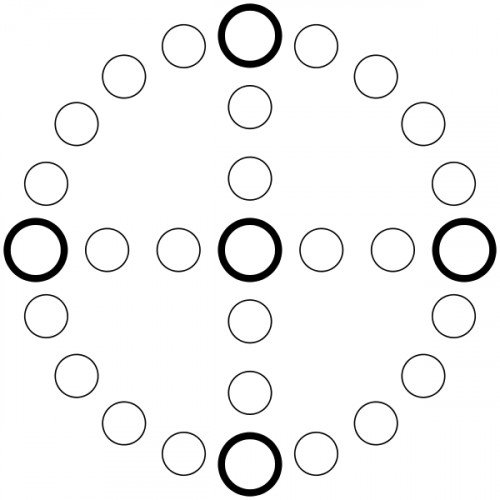BUL VS CROSS AND CIRCLE GAME

BUL
Bul (also called Buul, Boolik or Puluc) is a running-fight board game originating in Mesoamerica, and is known particularly among several of the Maya peoples of Belize and the Guatemalan highlands. It is uncertain whether this game dates back to the pre-Columbian Maya civilization, or whether it developed in the post-colonial era after the arrival of the Spanish conquistadores. Stewart Culin described the game in the 24th Annual Report of the Bureau of American Ethnology: Games of North American Indians published in 1907. R. C. Bell referred to the game in Board and Table Games from Many Civilizations. Both of these descriptions were based on the eyewitness accounts of others. Lieve Verbeeck, a linguist studying Mayan language, witnessed the modern version of the game being played by Mopan and Kekchi Maya in Belize It is not known exactly when the game was developed or what the original rules were as very few records survived the invasion by the conquistadors between the 15th and 17th centuries. Stewart Culin organised the games in his anthology into those he thought had an influence from Europe in their creation. Bul is not listed among these, and in his opinion the game must have developed before Europeans arrived in Central America. There are a variety of ways to play the game, as Verbeeck's account shows. The game could be played by two people, or by two equal-sized teams. The overall objective is to capture and subsequently kill the playing pieces of the opposition, so the game is in essence a war game. The playing area is divided into equal spaces using rods placed parallel to each other. The two players have control of a base at either end of the play area. The players take an even number of stones or figurines (or any suitable playing piece) and place them in their respective bases.
Statistics for this Xoptio

CROSS AND CIRCLE GAME
Cross and circle is a board game design used for race games played throughout the world. The basic design comprises a circle divided into four equal portions by a cross inscribed inside it like four spokes in a wheel; the classic example of this design is Yut. However, the term "cross and circle game" is also applied to boards that replace the circle with a square, and cruciform boards that collapse the circle onto the cross; all three types are topologically equivalent. Ludo and Parcheesi (both descendants of Pachisi) are examples of frequently played cruciform games. The category may also be expanded to include circular or square boards without a cross which are nevertheless quartered (Zohn Ahl), and boards that have more than four spokes (Aggravation, Trivial Pursuit). The game board for the Aztec game Patolli consists of a collapsed circle without an interior cross and thus has the distinction of being a cross that is a circle (topologically), without being a cross plus circle. Tokens are moved around spaces drawn on the circle and on the cross, with the goal of being the first player to move all tokens all the way around the board. Generally the circle of the cross and circle forms the primary circuit followed by the players' pieces. The function of the cross is more variable; for example, in Yut the cross forms shortcuts to the finish, whereas in Pachisi the four spokes are used as player-specific exits and entrances to the pieces' home. In non-race games (like Coppit and Trivial Pursuit) all paths may be undifferentiated in function.